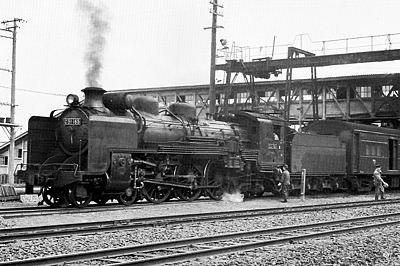
C51 No.165
Tomakomai, Muroran line during Jul 1959.
(Photo credit to S.Sumino)
Japanese
|
1919 - 1965 A middle to large Tender-Engine for main and sub-main line passenger trains. |

C51 No.165 Tomakomai, Muroran line during Jul 1959. (Photo credit to S.Sumino) |
|
Forming the basis for the imported US engine Class 8900,
the Ministry of Railways began the development of the first Japanese domestically produced standard high speed passenger engine. And so, in October of 1919, the first Class 18900 express engine came on the scene. The 18900 was the first to adopt the 1,750 mm driving wheel diameter. This diameter of 1,750 mm became the standard size for later main-line passenger models. First eighteen engines No.18900 - 18919 were produced in the Hamamatsu workshop (Serial No.1-18) in the Ministry of Railways as the test model. And the other engines were manufactured by private companies.
After its appearance, they went into arterial main lines, much like that of Hakodate, Tohoku, Tokaido and Sanyo main lines. All expresses were replaced with the C51. During October of 1930, the C51 was chosen for pulling the first Japanese Super Express "Tsubame (swallow)" between Tokyo and Kobe. Its successor, the high speed engine C53 already made its appearance during 1930. But C51 was chosen because it was time-proven. However, C51 moved over to the more higher performance engine C53 for main-line operation, and the C51 was turned over to sub-main lines. During the year of 1939, sixteen C51s were done in standard gauge (1067mm->1435mm), and transferred to China, and all never returned home again. The more modern performance engine class C57 appeared after WW2, C51's active area was getting smaller and smaller. A part of C51 was modernized, for example, changing Box-Wheels ...etc. During 1953, 270 C51s were still active all over the Japanese sub-main lines, with the exception of 19 which were moved out to China and war-damaged (No.133,194 and 235). However, the culling of C51's began in 1954, and were decreased to about 100 during 1961. 10 years later, during 1964, the number was decreased to 14. They were ; 2 in the Niitsu depot (No.57 and 193) for the Uetsu and Banetsu-West line, 2 in the Umekoji depot (No.124 and 275) for the Sanin line, Kyoto end, 3 in the Kameyama depot (No.209, 225 and 240) for the Kansai line, 2 in the Yonago depot (No.80 and 260) for the Sanin line, Yonago section, 4 in the Yoshimatsu depot (No.94, 107, 142 and 272) for the Kitto and Hisatsu line, 1 in the Tosu depot (No.251) ... out of service. Finally, their last appearance was Umekoji's C51 No.271 during the fall season in 1965. Unfortunately, this last C51 was scrapped for the reason that the JNR did not understand her historical value at that time. (No.271's registration was crossed off on the 20th of January 1966, and Tosu depot's No.251 was on the 23rd of February 1966.) Consult please .... Superexpress Tsubame |
| Primary ran line in last 10 years |
Hakodate, Muroran, Ou, Uetsu, West-Banetu, Hokuriku, Kansai ... etc
| Last line/depot and year |
Sanin line / Umekoji, Tosu, Yoshimatu dept Feb 1966
| Restored engine (2017) |
none
| Preserved engine (2017) |
4 (No.5, 44, 85, 239)
| |
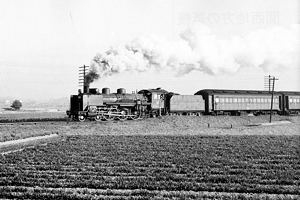
|
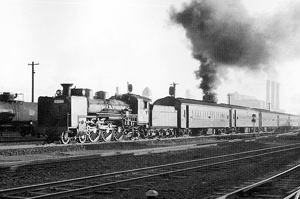
| ||||
|
C51 pulling a commuter train near Horyuji Kansai line. Mar.1954. (Photo credit to S.Sumino) |
C51_166, at Tomakomai, Muroran line. Jul. 1959 (Photo credit to S.Sumino)
| 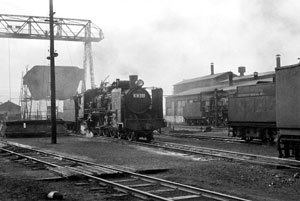
| 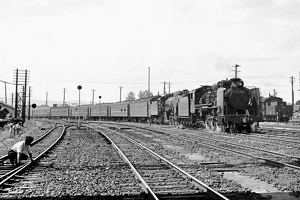
C51_251 at Haiki depot, Sasebo line Apr.1959.
| (Photo credit to S.Sumino)
Shown here is a C51_284 double headed up-express | just leaving Aomori during Jul.1959. (Photo credit to S.Sumino) |

| Configuration | 4-6-2 | Dimensions Length (mm) | 19994 |
| Engine Weight (Operating tons) | 69.6 | Driver size (mm diameter) | 1750 |
| Boiler pressure (Kg/cm2) | 13.0 | Max Tractive effort (tons) | 11.0 |
| Driver Max Power (PS) | 1040 | Max Speed (km/h) | 100 |
| Manufactured years | 1919-1928 | Total production | 289 |
| Gauge | 3ft 6in (1067mm) |
Introduction |
Go to Top |